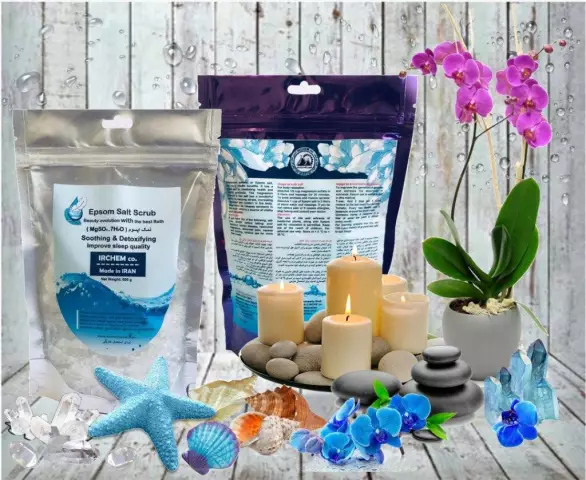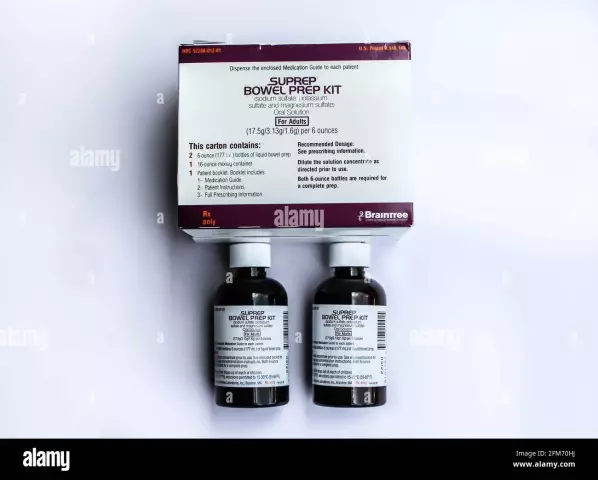- Author Rachel Wainwright [email protected].
- Public 2023-12-15 07:39.
- Last modified 2025-11-02 20:14.
Atropine sulfate
Atropine sulfate: instructions for use and reviews
- 1. Release form and composition
- 2. Pharmacological properties
- 3. Indications for use
- 4. Contraindications
- 5. Method of application and dosage
- 6. Side effects
- 7. Overdose
- 8. Special instructions
- 9. Application during pregnancy and lactation
- 10. In case of impaired renal function
- 11. For violations of liver function
- 12. Use in the elderly
- 13. Drug interactions
- 14. Analogs
- 15. Terms and conditions of storage
- 16. Terms of dispensing from pharmacies
- 17. Reviews
- 18. Price in pharmacies
Latin name: Atropine sulfate
ATX code: A03BA01
Active ingredient: atropine (atropine)
Producer: Dalkhimpharm, JSC (Russia), Experimental plant GNTSLS, LLC (Ukraine)
Description and photo update: 2019-02-09
Prices in pharmacies: from 26 rubles.
Buy

Atropine sulfate is an M-anticholinergic blocker with antispasmodic and mydriatic action. Reduces the tone of smooth muscle organs (urinary tract, abdominal organs, bronchi, uterus), reduces the secretion of the pancreas, bronchial, gastric, sweat and salivary glands, increases intraocular pressure, causes paralysis of accommodation, increases heart rate.
Release form and composition
Dosage form - solution for injection 0.05% and 0.1%: colorless transparent liquid [1 ml in ampoules, 10 ampoules in a cardboard box complete with an ampoule knife or scarifier (when using ampoules with break points, rings and notches, a knife for opening may be absent); 5 ampoules in blisters, 1 or 2 packages in a cardboard box; each pack also contains instructions for the use of Atropine sulfate].
Active substance: atropine sulfate, in 1 ml of solution - 0.5 or 1 mg.
Auxiliary components: water for injection, hydrochloric acid.
Pharmacological properties
Pharmacodynamics
Atropine is a m-cholinergic receptor blocker, a natural tertiary amine. It is believed that the substance binds equally to the m 1 -, m 2 - and m 3 subtypes of muscarinic receptors. It has an effect on central and peripheral m-cholinergic receptors.
The main effects of atropine:
- decrease in secretion of gastric, salivary, sweat, bronchial glands;
- decreased tone of smooth muscles of internal organs (including bronchi, organs of the digestive system, urethra, bladder);
- decreased motility of the gastrointestinal tract;
- decrease in the secretion of tear fluid.
In addition, atropine promotes the development of mydriasis, accommodation paralysis, practically does not affect the secretion of bile and pancreas.
When used in moderate therapeutic doses, atropine moderately stimulates the effect on the central nervous system and has a delayed but prolonged sedative effect.
The ability of atropine to eliminate tremors in Parkinson's disease is due to its central anticholinergic effect. In toxic doses, the substance can lead to excitement, agitation, hallucinations, and coma.
Atropine reduces the tone of the vagus nerve, as a result of which the heart rate increases (with a slight change in blood pressure), the conduction in the His bundle increases.
Atropine does not significantly affect peripheral vessels when used in therapeutic doses, but vasodilation is noted in case of an overdose.
Pharmacokinetics
Atropine is widely distributed throughout the body. Metabolism occurs in the liver by enzymatic hydrolysis. Binds to plasma proteins at a level of 18%.
Penetrates the blood-brain barrier, placenta and breast milk. After 0.5-1 hour, it is found in the central nervous system in significant concentrations. The half-life is 2 hours.
It is excreted by the kidneys unchanged and in the form of hydrolysis and conjugation products in approximately the same ratio.
Indications for use
0.05% and 0.1% solution of Atropine sulfate is used in the following cases:
- spasms of the bronchi, urinary tract, intestines, gallbladder and bile ducts;
- bronchitis with mucus overproduction;
- bronchial asthma;
- cholelithiasis;
- acute pancreatitis;
- cholecystitis;
- exacerbation of gastric ulcer and 12 duodenal ulcer;
- pylorospasm;
- atrioventricular block;
- bradyarrhythmias developed as a result of increased vagus nerve tone (including bradycardia);
- hypersalivation (parkinsonism, poisoning with salts of heavy metals);
- poisoning with anticholinesterase and cholinomimetic (including organophosphorus) agents;
- laryngospasm (for prevention);
- premedication before surgery (for the prevention of laryngo- and bronchospasm, reduction of vagal cardiac reflexes and secretion of the salivary and bronchial glands);
- X-ray studies of the gastrointestinal tract.
Contraindications
- intestinal atony;
- reflux esophagitis;
- obstructive bowel disease;
- hernia of the esophageal opening of the diaphragm;
- nonspecific ulcerative colitis;
- toxic megacolon;
- paralytic ileus;
- hepatic and / or renal failure;
- hyperplasia of the prostate;
- mitral stenosis;
- tachyarrhythmias;
- cardiac ischemia;
- severe congestive heart failure;
- obstructive diseases of the urinary tract;
- angle-closure glaucoma or a predisposition to it;
- myasthenia gravis;
- pregnancy complicated by gestosis;
- period of breastfeeding;
- hypersensitivity to the components of Atropine sulfate.
Carefully:
- hyperthyroidism;
- arterial hypertension;
- hyperthermia;
- pregnancy;
- age over 40 years (due to the risk of manifestation of undiagnosed glaucoma).
Atropine sulfate, instructions for use: method and dosage
Atropine sulfate is administered subcutaneously (subcutaneously), intravenously (intravenously) or intramuscularly (intramuscularly).
Recommended schemes of use:
- relief of renal and hepatic colic, acute pain in pancreatitis, gastric ulcer and duodenal ulcer, etc.: i / m or s / c in a dose of 0.25-1 mg atropine sulfate (0.25-1 ml of solution);
- bradycardia: intravenous 0.5-1 mg, if necessary, another dose is administered after 5 minutes;
- premedication: i / m in a dose of 0.4-0.6 mg 45-60 minutes before anesthesia;
- poisoning with anticholinesterase agents or m-cholinostimulants: intravenous 1.4 ml of 0.1% solution of Atropine sulfate, usually in combination with cholinesterase reactivators.
For children, the dose of atropine is 0.01 mg per kilogram of body weight.
Side effects
- headache, dizziness;
- dry mouth, constipation;
- intestinal and bladder atony;
- tachycardia;
- increased intraocular pressure, mydriasis, photophobia, accommodation paralysis;
- difficulty urinating;
- violation of tactile perception.
Overdose
The main symptoms: dryness of the mucous membrane of the nasopharynx and oral cavity, impaired speech and swallowing, hyperthermia, dry skin, mydriasis, impaired memory, psychosis, hallucinations, speech and motor excitement.
Therapy: the use of anticholinesterase and sedatives.
special instructions
Atropine sulfate crosses the placental barrier. Adequate and strictly controlled clinical studies on the safety of the drug during pregnancy have not been conducted. In the case of intravenous administration of the drug to a pregnant woman, shortly before delivery, the fetus may develop tachycardia.
Influence on the ability to drive vehicles and complex mechanisms
During treatment, it is advised to refrain from driving and performing any work related to the speed of reactions and increased attention.
Application during pregnancy and lactation
If it is necessary to use Atropine sulfate during pregnancy, it must be borne in mind that the active substance penetrates the planetary barrier.
In pregnancy complicated by preeclampsia, the drug is contraindicated (due to the risk of increased blood pressure).
For women who are breastfeeding, drug therapy is contraindicated.
With impaired renal function
Atropine sulfate is contraindicated in renal failure.
For violations of liver function
Atropine sulfate is contraindicated in liver failure.
Use in the elderly
In patients over the age of 40, the use of the drug requires caution, which is associated with the danger of undiagnosed glaucoma.
Drug interactions
The drug weakens the effect of anticholinesterase agents and m-cholinomimetics.
Promethazine and diphenhydramine enhance the effect of atropine, guanethidine can reduce its hyposecretory effect.
With the simultaneous use of nitrates, the risk of increased intraocular pressure increases.
In the case of combined use with procainamide, an increase in anticholinergic action is noted.
Analogs
Atropine sulfate analogs are Atropine, Atropine Nova.
Terms and conditions of storage
Store in a dark place, out of reach of children, at a temperature of 2-30 ° C.
The shelf life is 5 years.
Terms of dispensing from pharmacies
Dispensed by prescription.
Reviews about Atropine sulfate
Reviews of Atropine sulfate characterize it as an effective remedy. At the same time, the importance of compliance with the prescribed dosage regimen is indicated, which is associated with a high risk of adverse reactions.
Price for Atropine sulfate in pharmacies
The approximate price for Atropine sulfate (10 ampoules of 1 ml) is 13-34 rubles.
Atropine sulfate: prices in online pharmacies
|
Drug name Price Pharmacy |
|
Atropine sulfate 0.1% solution for injection 1 ml 10 pcs. RUB 26 Buy |

Anna Kozlova Medical journalist About the author
Education: Rostov State Medical University, specialty "General Medicine".
Information about the drug is generalized, provided for informational purposes only and does not replace the official instructions. Self-medication is hazardous to health!






